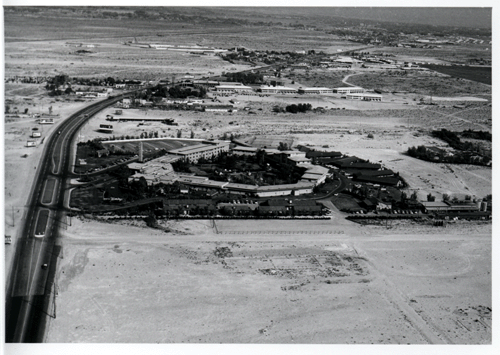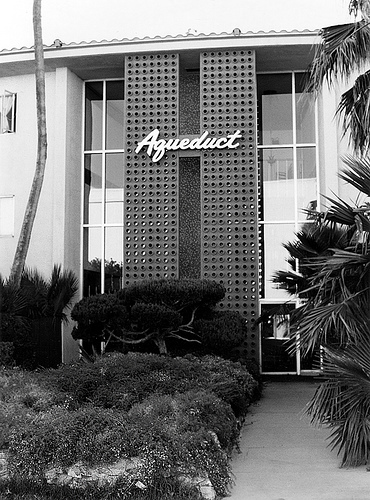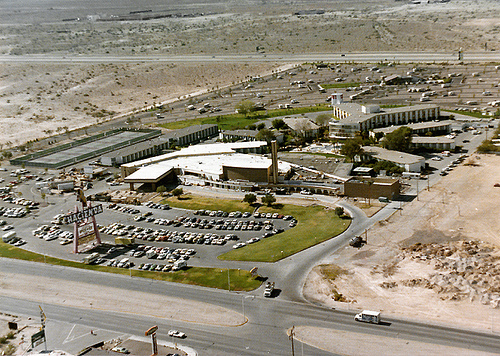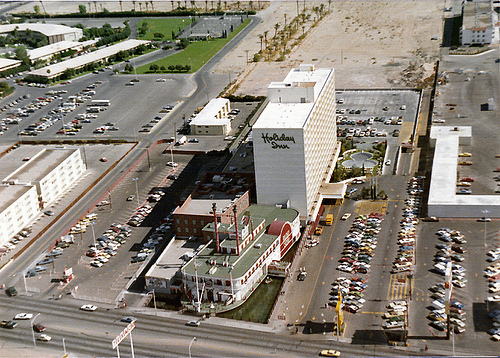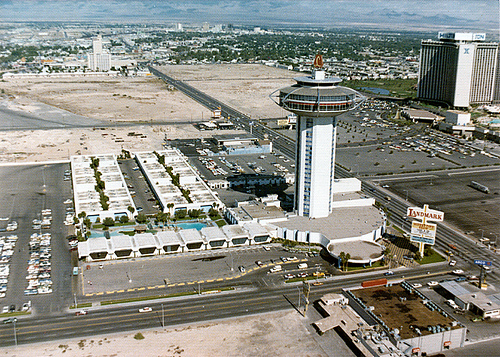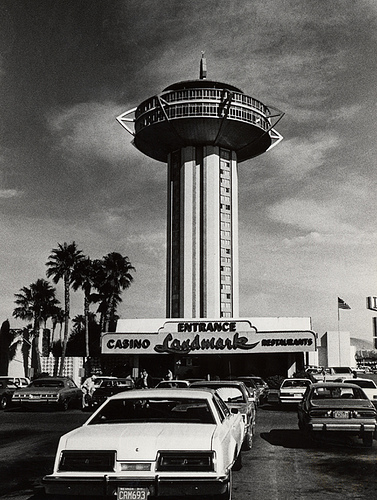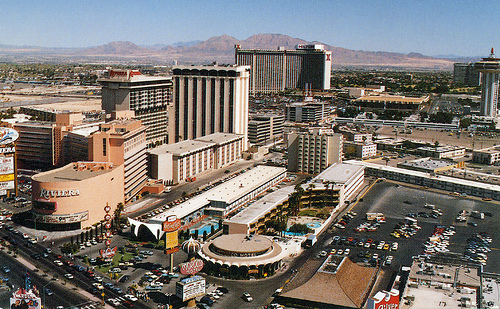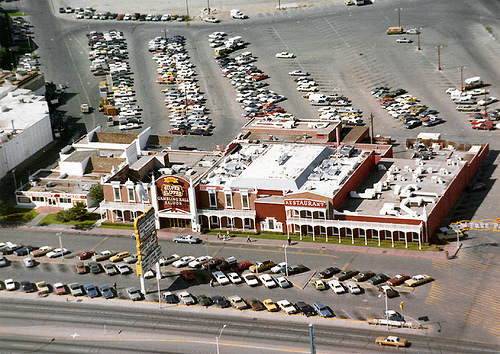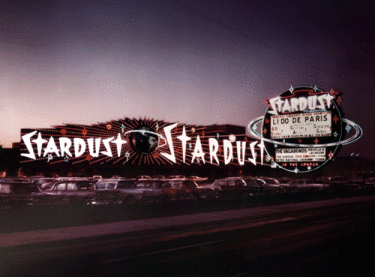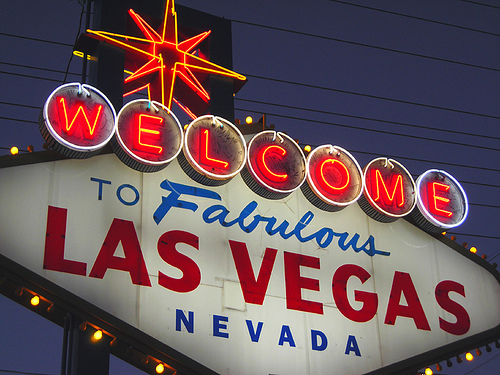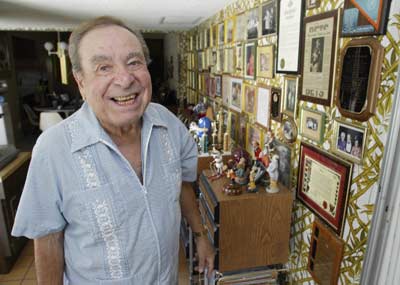
One of my most favorite people in the world and one of my most favorite interviewees, Sam Butera has passed away. He was living the retired life in Las Vegas, long his home. He was 81.
He was best known as Louie Prima's sax player but Sam was in a category all by himself. He grew up in New Orleans and had bounced around the French Quarter enough to make a name for himself. He had joined up with Louie Prima more than once.
Sam got the call from Prima on Dec. 24th, 1954 to come and join him and Keely Smith in Las Vegas. They had a contract with to play the Casbah Lounge at the Sahara Hotel.
Sam told Prima that the contract would have to wait until 26th as it was Christmas Day and he couldn't leave his family and it would be hard to round up the band.
The next day, Sam Butera and the (hastily named) Witnesses were headed for Las Vegas and the Las Vegas Strip would never be the same.
"He called me on Dec. 24th and said 'Sam, you want to come to Vegas?' and I said when and he said tomorrow. I told him it was Christmas and I got my kids and I can't leave on Christmas but I could be there on the 26th. He said good, see you then." Sam Butera told me in an interview in 2003. "I brought along my drummer and my piano player."
The drummer and piano player barely had time to meet Prima and Smith before going on stage that night. Louis Prima introduced Keely Smith, Sam Butera and the Witnesses. The audience liked the name and it stuck. The lounge entertainers performed sets between midnight and 6:00 am, every night. They rotated generally with a comedian so that there was always entertainment in the lounge.
"And there was no one, ever, in the history of show business, that did the business that this man did from midnight until 6 in the morning. You could not get into that club. That was really one of the biggest things that happened in Vegas," says Miller. "It created people like Shecky Green. All the lounge acts started with Louis Prima."
Prima, Smith, Butera and the Witnesses kept the joint jumping all night long.
"We were the hottest act in the world." remembers Butera.
Louie, Keely, Sam and the Witnesses held court in the Casbah Lounge for the next seven years, playing sets from midnight to dawn. "Everyone in town was there, Sinatra, Martin, Sammy Davis, Sophie Tucker, to hear us play because we were the hottest thing in the country, in the world" Sam told me in a long interview in 2003.
He loved Louie like an older brother and when Louie and Keely divorced in the early 1960s, Sam stayed with Louie and they continued their lounge act with Louie's new wife, Gia.
During our interview, Sam got teary talking of Louie's later years and the coma that befell him in the early 1970s and that he never recovered from.
"Jump, Jive and Wail" and "Just a Gigolo" are just two of the standards that Sam Butera helped make essential swing music listening.
Thanks to David Lee Roth and The Gap ads, Sam was rediscovered in the 1980s and again in the late 1990s.
He toured until he retired a few years back with his group, The Wildest. I saw them from the lounge at New York, New York to the stages of Fullerton, Hollywood and back to Las Vegas.
I had the opportunity to do an extensive biographical interview with him in 2003. We saw each other after that Claude Trenier's funeral where he cried on my shoulder and again at a supper club where he and the Wildest were preforming in Pasadena. He always took time out to talk with me and my husband after the show.
The Sax Man who loved Louie Prima like a brother and who called Las Vegas home will be missed by all of us who remember when the hottest music could be heard for a two drink minimum and the will to stay up till dawn.
I will miss him dearly as he was one of the pioneers of the Las Vegas Strip sound and one of the best.
I hope they dim the lights on the Strip in his honor.
I know that for the next few days, it will be a tad sadder in the VeryVintageVegas neighborhood where Sam lived. And I hope that my pals will join me in raising a glass (or three) to Sam's honor whenever we gather this week and weekend.
Here's to Sam, one of the best and one of the Wildest!
From the Times-Picayune:
Sam Butera, the hard-driving, hard-swinging New Orleans saxophonist who was Louis Prima's longtime musical partner, died Wednesday in Las Vegas following a long illness. He was 81.
Mr. Butera joined Prima's band in 1954. With singer Keely Smith, they
built one of the most popular acts in the golden age of Las Vegas. Mr.
Butera cooked up the arrangements that gave the likes of "Just a
Gigolo," "I Ain't Got Nobody" and "Jump Jive An' Wail" maximum impact.
"Louis's ace-in-the-hole was Sam Butera," said Gia Prima, the fifth of
Louis's five wives and the singer in his band from 1962 to 1975. "That
animal attraction that they had, with Sam's honking sax and Louis's
jumping and jiving -- without Sam, Louis couldn't have pulled it off."
Mr. Butera grew up in the 7th Ward. His father owned Poor Boys Grocery
& Meat Market. One evening the elder Butera took his son to see a big
band, and asked the boy which horn he liked the best.
"The saxophones were closest, so I pointed to the saxophones," Mr.
Butera recalled in a 1996 interview. "The next day I had a horn."
A prodigy, he turned pro at 14, serving as the human jukebox for
strippers on Bourbon Street. "I worked at every joint on that street,"
he recounted. "You name it and I worked it. All those girls wanted to
do was mother me."
At 18, he was voted the "Outstanding Teenage Musician in America" by
Look Magazine at Carnegie Hall in New York. After graduating from Holy
Cross High School, he considered Notre Dame University scholarships
for music and track and a career in mechanical engineering. Instead he
hit the road with big bands led by Ray McKinley, Tommy Dorsey and Al
Hirt.
By late 1954, he'd cut several records under his own name. He often
performed at the 500 Club on Bourbon Street, which was owned by
Prima's brother Leon. Looking to staff his new band at the Sahara
Hotel in Las Vegas, Prima scouted Mr. Butera at the 500 Club and
offered him a job.
Mr. Butera had never been to Vegas, then a desert stopover with 30,000
inhabitants. He banked as much as $700 a week backing Lili Christine
the Cat Girl and other strippers on Bourbon Street; his first Sahara
paycheck was $250. His wife, Vera Marie, wanted to return to New
Orleans; Mr. Butera insisted they stay.
"I thought it would be a good move," he said.
It was. Mr. Butera started writing arrangements for Prima's band, the
Witnesses. "That's when it happened," he said. "The sound, you know?"
That sound was an explosive mixture of jump blues, jazz, top-notch
crooning and no-holds-barred entertainment. During a seven-year run at
the Sahara with the Witnesses, they defined Las Vegas cool. On-stage,
Mr. Butera and Prima cut up big-time, blazing away at each other
during trumpet and sax duels, thrashing around, stomping through the
crowd.
"His contributions to Louis are immeasurable," said Ron Cannatella, a
radio host and director of the Louis Prima archives. "They were a
team. They worked perfectly together."
Mr. Butera's enormous tone stood toe-to-toe with Prima's manic energy.
But for all the antics, Mr. Butera was also a serious musician who
insisted the music be correct.
"Every night before the shows, you could hear Sam in the dressing room
running scales and fussing over his reeds," Gia Prima recalled. "He
wanted everything to be perfect. I don't think there's another tenor
sax man that could touch him."
Their popularity extended far beyond Vegas. After scoring a national
hit with "That Old Black Magic" in 1959, they sold out as many as four
shows nightly at New York's Copacabana -- more than even Frank
Sinatra.
Through the mid-1970s, they made the rounds of the popular TV talk
shows of the day, chatting with the likes of Merv Griffin, Johnny
Carson, Dinah Shore and Dean Martin.
"We had fun, and we played good music, what the people wanted to
hear," Mr. Butera said in 1996. "And it was our own thing. Then
everybody started copying our style of music."
After Louis Prima fell into an irreversible coma in 1975, Mr. Butera
continued to record and tour with Frank Sinatra and others. In 1985,
former Van Halen singer David Lee Roth launched his solo career with a
copy of Mr. Butera's "Just a Gigolo" / "I Ain't Got Nobody"
arrangement. Ex-Stray Cats frontman Brian Setzer scored a Grammy for
his cover of the Prima/Butera classic "Jump Jive An' Wail."
During the swing revival of the 1990s, Mr. Butera was perceived as one
of the music's originators. He and his band, the Wildest, enjoyed
long, successful residencies in Nevada, Atlantic City and elsewhere,
perpetuating the swing and shtick of vintage Vegas.
"He carried the legacy on," Gia Prima said. "Sam could really
reproduce that sound. If you wanted to hear that music, you had to go
see Sam. It was amazing that he kept on as long as he did."
He made his New Orleans Jazz & Heritage Festival debut in 2002. In the
Economy Hall Tent, a tuxedoed Mr. Butera declared his intention to
play "music you can relate to. All old songs. None of that new s---."
He delivered his usual repertoire of lounge-worthy Viagra jokes and
airtight versions of "Jump Jive An' Wail," "Just a Gigolo" and "Down
On Bourbon Street." "That's happy music, folks," he said.
During occasional New Orleans visits, Mr. Butera often purchased
pastries for his mother at Angelo Brocato Ice Cream & Confectionery on
North Carrollton Avenue. The title of his 1996 CD proclaimed that "The
Whole World Loves Italians." He last came to town in 2003 to be
induced into the Italian-American Hall of Fame. Nancy Sinatra, Tony
Bennett and Jerry Lewis sent tributes; Pete Fountain presented the
award.
When failing health made travel difficult, Mr. Butera retired. He
entered a Las Vegas hospital in January, and never left.
Next year is the 100th anniversary of Louis Prima's birth. Gia Prima
is planning numerous commemorations. With news of Mr. Butera's
passing, "my heart is saddened," she said. "For me it's almost like
losing Louis again."
Survivors include his wife of 60 years, Vera, two sons and two
daughters. Funeral arrangements are incomplete.
From our pal Jerry Fink at the Las Vegas Sun:
Another link to Las Vegas’ storied past was cut Wednesday morning with the passing of legendary jazz saxophonist Sam Butera, sideman to another Vegas legend, Louis Prima.
Family friends said Butera died at about 6 a.m. at Sunrise Hospital, where he had been since early January suffering from the effects of Alzheimer's Disease.
Butera, who retired in 2004, would have been 82 in August.
Prima died at the age of 67 in 1978, three years after lapsing into a coma during surgery to remove a brain tumor.
The music of Prima and Butera resurfaces from time to time, played in film sound tracks an commercials. A Gap commerical in the '90s, featuring “Jump, Jive and Wail” gave Butera’s career a boost.
“Louis Prima’s true ace in the hole for 21 years was Sam Butera,” Prima’s widow, Gia Maione, said during a telephone call from her home in Florida. “I don’t care what vocalists were with Louis, his true ace in the hole was Sam Butera. Side by side, Louis and Sam kicked Las Vegas’ butt for 21 years.”
Maione joined Prima’s group after Prima and vocalist Keely Smith divorced in 1961.
“I really do not believe over all of these years that Sam Butera got the accolades he deserved as a tenor saxophone player,” Maione, 67, said. “I defy anyone to name someone that played better tenor sax that Sam Butera.
“From the day I got the job with Louis, before every show every night, emanating from the dressing room you would hear Sam running his scales, running his fingering, making sure his mouthpiece and reed were perfect. He was a technician beyond belief with that instrument, let alone the showman that he was. And you put those two side by side, Prima and Butera, that was it.”
She says her husband didn’t get the credit he deserved, either.
“Both of them were such great showmen and they had so much fun that people overlooked the skill because they were having too much fun,” she said.
Maione remained close to Butera and his family after Prima died in a hospital in New Orleans, the home town of both Prima and Butera.
“It’s a very, very sad day,” she said. “We were very close through the years. I was in very close communications with Sam, especially since he retired. I’ve been in touch with his wife, Vera, weekly since he became ill. He was in the hospital from Jan. 3 until now. He was in the grips of Alzheimer’s. He lapsed into a coma, and then he was gone.”
Sam and Vera Butera were married 62 years.
“They were high school sweethearts,” Mainoe said.
The couple had four children.
Maione said four or five days ago Mrs. Butera was injured while going to the hospital to see her husband.
“She was walking through the parking lot at hospital and got hit by a truck,” Maione said. “Miraculously, nothing was broken but she has an injury to her back. She’s at home now but isn’t speaking to anyone because of the severe pain form her back. The family doesn’t know when the funeral arrangements will be made. They don’t know when their mother will be able to attend the funeral.”
Butera was born on Aug. 17, 1927. His father owned a butcher shop and played guitar and the concertina in his spare time. Butera studied clarinet in school but eventually turned to the saxophone. At the age of 18 was featured in Look magazine as one of the top young jazzmen in the country.
Butera was also an excellent athlete. He received a track scholarship and a music scholarship to Notre Dame, but a leg injury ended his track career and he decided to pursue music instead of going to college.
He quickly began performing around the country with the top bands of the day, including Tommy Dorsey and Joe Reichman. His said his major influences in those years were Charlie Ventura, Lester Young, Gene Ammons, Charlie Parker and Big Jay McNeely.
Butera formed his own group after returning to New Orleans and began a four-year engagement at the 500 Club.
Ron Cannatella, official archivist for Prima Music LLC in New Orleans, had a personal relationship with Butera.
“Both of my grandfathers knew Sam,” Cannatella said.
He said Prima’s brother, Leon, saw Butera performing at the Perez’ Oasis club and told Louis about him. Prima liked what he saw and in 1954 when he and Keely Smith were booked at the Sahara in Las Vegas he asked Butera to join them.
“He wanted Sam to start on Christmas Eve, 1954, but Sam told Louis he needed to spend Christmas with his family, which he did,” Cannatella said. “The Day after Christmas, on Dec. 26, 1954, Sam joined Louis in Las Vegas and was his sidekick and sideman until 1975, when Louis was operated on for the brain tumor.”
Together Prima and Butera appeared on every major television show in the '60s and '70s, including Johnny Carson, Dinah Shore, Dean Martin, Danny Thomas, Bob Hope and Mike Douglas.
“Their last appearance together on television was 'The Merv Griffin Show' in 1975,” Cannatella said.
They made many albums together, including “The Wildest” and “The Call of the Wildest” (both in 1957), but Butera also made albums on his own, including “The Rat Race” (in 1960), which was a soundtrack from a film Butera appeared in with Tony Curtis.
They recorded albums for Capital, Dot and Buena Vista record labels, Cannatella said.
They appeared in movies together (“Hey Boy, Hey Girl” and “Twist All Night”).
“Sam also worked with Louis on the film 'Jungle Book’ for Disney,” Cannatella said.
Butera was not selfish with his music.
“Back when Allen Toussaint composed the song 'Java,’ Allen had initially given the song to Sam but Sam felt that Al Hirt should be the one to record it and Sam gave it Al and it became a big hit.”
After Louis became incapacitated, Butera’s career continued to flourish until the early 2000s when work in Las Vegas began to slow down and he had to spend a lot of time on the road.
He made his last appearance in New Orleans in 2003 when he was inducted into the Hall of Fame there.
Cannatella visited with Butera in 2005, after Hurricane Katrina devastated his home town.
“He was saddened to find out so many of the clubs and places he had played were no longer there,” Cannatella said. “Sam was a wonderful guy, a family oriented man.”
He called Butera’s passing, “A great loss to his family and to the musical world, because Sam was one of the greatest saxophone players of all time.”
Louis Prima Jr. knew Butera well because of his father, but had no personal relationship with him.
“I’ve known him most of my life,” said Prima, who has his own band and is trying to keep his father’s music alive, though it is difficult in these economic times. “Unchallenged, without a doubt Sam Butera was the most talented, greatest sax player there ever was and probably will be.
“He was an incredible musician who never missed a beat.”
Prima’s sister Lena has performed a tribute show to her father for many years.
She says she and Butera never performed together, but once placed opposite each other at Palace Station lounges.
“There wasn’t anybody like him,” Lena Prima said. “He had that New Orleans style and sound that a lot of sax players who came out of New Orleans had. But he was special, one of a kind. In combination with my father, they were amazing. He was very talented. I loved his singing too. He had a really unique singing voice.”


